随着全球气候变暖以及城市化和工业化的快速发展,淡水资源在农业领域的应用比例越来越少,严重制约了农业的可持续发展[1-2]。尤其是在我国的西北干旱区,水资源供需矛盾十分严峻[3],地下水超采问题严重[4],因此,发展节水灌溉是促进农业可持续发展的重要举措之一[5]。
库尔勒香梨(Pyrus sinkiangensis Yü)是新疆原产的优质特色水果,以库尔勒市为主要产区,栽种面积占新疆梨总面积的40%[6],是当地农业增效、农民增收的重要途径[7]。当前,库尔勒香梨栽种的灌溉方式以漫灌为主,年灌水量为14 000~18 000 m3·hm-2[8-9]。但对于水资源极度匮乏的内陆干旱区而言,漫灌会对香梨产业发展造成显著的不利影响[10]。因此,有必要探索新的果园灌溉技术,提高水分利用效率,节约水资源,促进库尔勒香梨产业的健康可持续发展。
目前果树上主要应用地表滴灌[11]、喷灌[12]、根区渗灌[13]、地下滴灌[14]以及涌泉根灌(surge-root irrigation,SRI)[15]等节水灌溉技术。其中,SRI 作为一种新型地下滴灌技术,通过毛管直接将水和肥料输送至果树根部,可以减小蒸发损失,提高水分利用效率,特别适宜于西北干旱区果园[16-17]。目前,对SRI的研究主要集中在灌水器的入渗特性[18]、涌泉根灌流量[19]、灌水器的深度[20]等方面,而对灌水效果的研究较少。李中杰[21]研究表明,与地下滴灌、地表滴灌相比,SRI提高了陕北山地苹果的可溶性糖含量、维生素C 含量以及产量。刘晓丽等[22]研究表明,与地表滴灌相比,SRI、根际环形多点源滴灌显著提高了陕北沙地枸杞的产量以及水分利用效率。戚飞[23]研究发现,与滴灌相比,SRI及陶瓷渗灌提高了苹果产量及水分利用效率。吴普特等[24]以陕北山地枣树为研究对象,通过与管灌、滴灌的比较,发现SRI 显著提高了枣树的果实品质和产量。
在新疆果园中使用SRI 技术时,易发生根区导水毛细管末端堵塞现象。因此,笔者在SRI 的基础上,在出水器两端连接2 根30 cm 长壁侧切φ4 mm导水毛管,为区别于SRI,本文称为改进涌泉根灌(modified surge root irrigation,MSRI),并通过设置3种MRSI 方式(交替MSRI、双侧MSRI、单侧MSRI)和2种复水模式(复水、不复水),以环境的净蒸发量作为制定灌水量的依据,探讨不同MSRI方式对库尔勒香梨果实品质、产量和水分利用效率的影响,旨在为MSRI技术在西北旱区梨园的应用提供理论依据。
1 材料和方法
1.1 试验区概况
试验于2022 年3 月至2023 年10 月在新疆库尔勒市香梨研究中心的香梨科研试验基地(41°11′N,86°15′ E,海拔901 m)进行。试验地属于暖温带大陆性干旱气候,光热资源丰富,年总日照时数为3000 h,无霜期平均为210 d,全年平均气温为11 ℃,年平均降水量不足60 mm,蒸发量大,主导风向东北风。土壤有机质含量(w,后同)为15.4 g·kg-1,全氮含量为0.8 g·kg-1,碱解氮含量为63.82 mg·kg-1,有效磷含量为24.2 mg·kg-1,速效钾含量为189.9 mg·kg-1。
试验品种为库尔勒香梨,树龄为8 a(年),砧木为杜梨,授粉树为鸭梨,东西向栽植,行距4 m,株距2 m,平均胸径7.89 cm,授粉方式为人工授粉,肥料的类型为有机肥,距离主干约100 cm 处开沟施肥,11月中旬施基肥1次,开沟宽、深均约为20 cm,隔年施羊粪100 m3·hm-2,开沟宽、深均约30 cm。园内无任何间作物,树形均为主干分层形。
1.2 试验设计
MSRI:灌水器进水口与置埋于地下30 cm的供水支管直接连接,两端出水器连接2根30 cm长壁侧切φ4 mm导水毛管,埋置时,导水毛管以端口向下、弧形安装于支管下方。田间安装方法如图1 所示。供水支管平行于树干行,距离树干50 cm。大田生产以支管为单位进行轮灌。以树干为中心,交替灌溉、单侧灌溉供水方式下,每棵树单侧支管安装有间距30 cm 灌水器8 个;双侧灌供水方式下,两侧供水支管按间距60 cm 安装4 个灌水器。灌水器流量为10 L·h-1。供试区每棵树的供水支管可独立供水,安装标定过的水表计量每次灌水量。
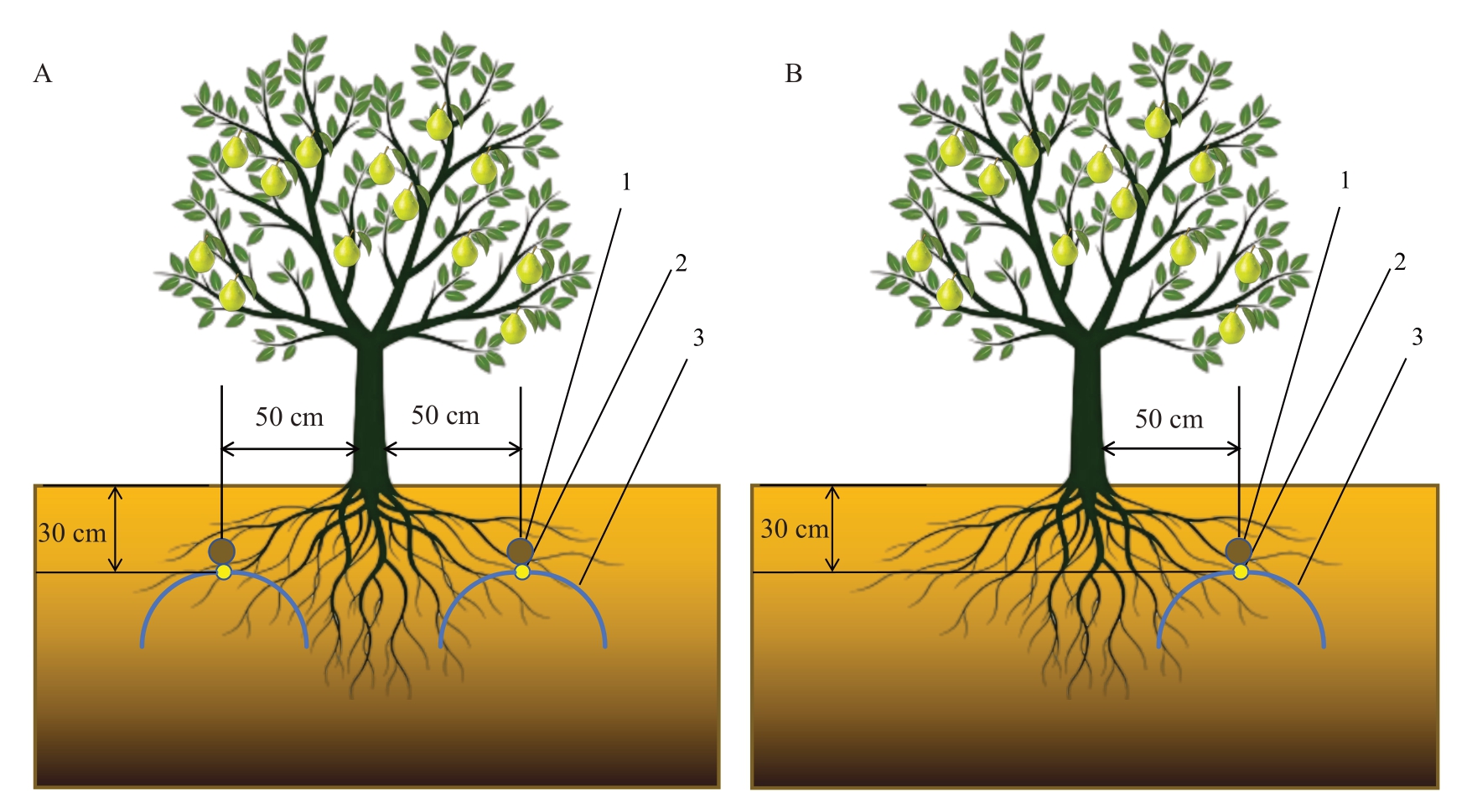
图1 MRSI 灌水器的田间布置示意图
Fig.1 Schematic diagram of the field layout for the modified surge root irrigation emitters
A.双侧MRSI 与交替MRSI;B.单侧MRSI;1.支管;2.灌水器;3.长壁侧切导水毛管。
A.Bilateral MRSI and alternating MRSI;B.Unilateral MRSI;1.Branch pipe;2.Emitter;3.Longwall lateral cut water guiding capillary tube.
2022年与2023年采用完全随机试验设计,设置灌溉方式与是否复水两个试验因素,以大水漫灌作为对照(CK)。试验设有2 个复水处理:R1(复水,在7 月中旬果实膨大期增加1 次漫灌,灌水量为300 mm)、R2(不复水),以及3 种MSRI 方式:交替MSRI(A)、双侧MSRI(B)、单侧MSRI(U)。7 个处理分别为:CK、R1A、R1B、R1U、R2A、R2B、R2U,每个处理3次重复,共计21个小区(图2)。

图2 试验小区布置图
Fig.2 Layout of the experimental plots
灌溉方案见表1。花期结束后开始试验,直至果实成熟。对照采用传统修畦大埂漫灌技术,每隔20 d 灌溉1 次,每次灌溉300 mm。MSRI 试验组的灌溉量以20 cm 标准蒸发皿的累计蒸发量(E20)为灌水依据。在灌水间隔内,蒸发皿累积蒸发量与水面蒸发系数(Kp=0.75)[25]相乘,得到各处理的单次灌水量。灌水量通过灌水管末端的水表控制计量,每10 d灌溉1次。
表1 2022 年和2023 年不同灌溉方式下灌溉日期和灌水量
Table 1 Irrigation date and amounts under different irrigation methods in 2022 and 2023
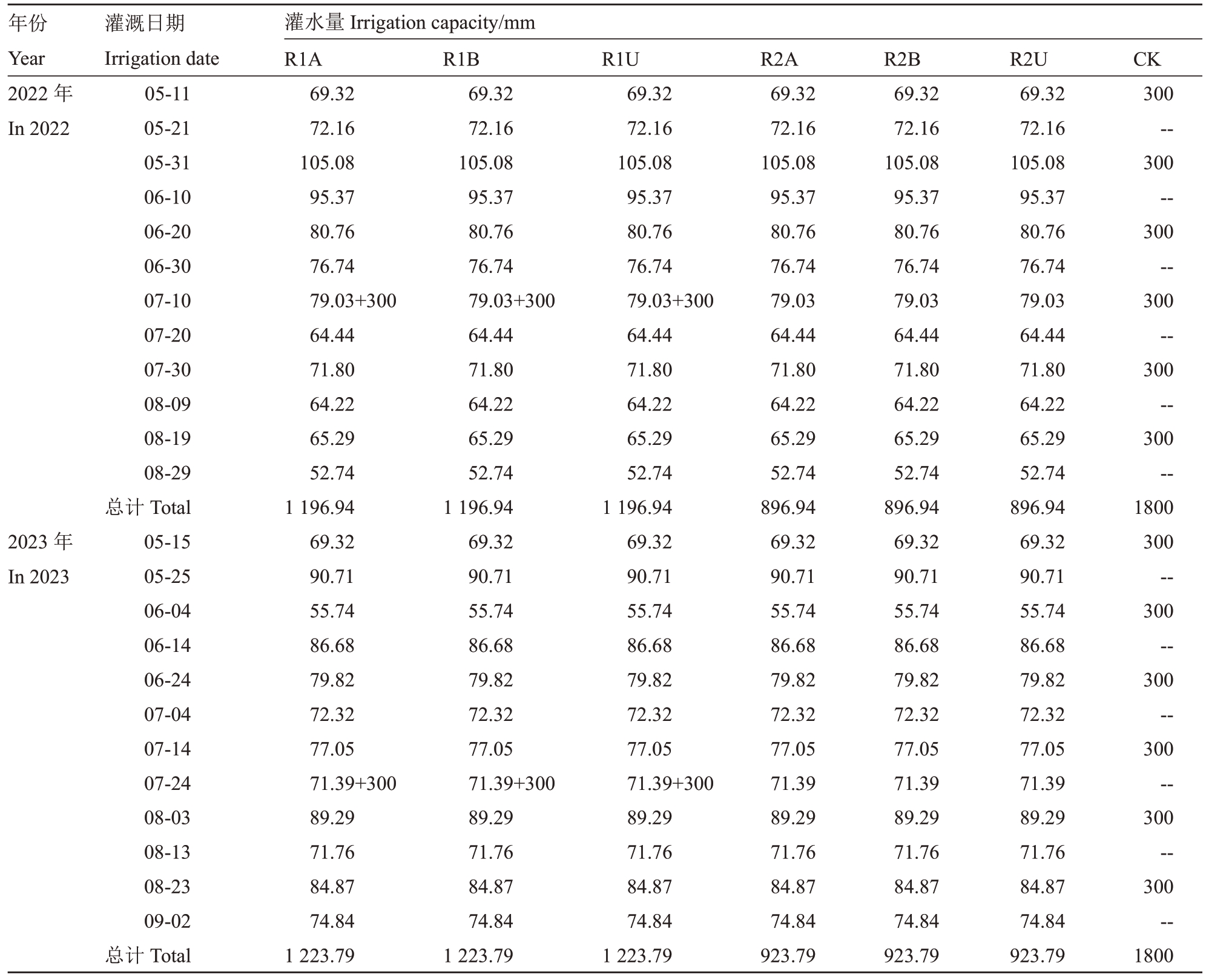
年份Year 2022 年In 2022 2023 年In 2023灌溉日期Irrigation date 05-11 05-21 05-31 06-10 06-20 06-30 07-10 07-20 07-30 08-09 08-19 08-29总计Total 05-15 05-25 06-04 06-14 06-24 07-04 07-14 07-24 08-03 08-13 08-23 09-02总计Total灌水量Irrigation capacity/mm R1A 69.32 72.16 105.08 95.37 80.76 76.74 79.03+300 64.44 71.80 64.22 65.29 52.74 1 196.94 69.32 90.71 55.74 86.68 79.82 72.32 77.05 71.39+300 89.29 71.76 84.87 74.84 1 223.79 R1B 69.32 72.16 105.08 95.37 80.76 76.74 79.03+300 64.44 71.80 64.22 65.29 52.74 1 196.94 69.32 90.71 55.74 86.68 79.82 72.32 77.05 71.39+300 89.29 71.76 84.87 74.84 1 223.79 R1U 69.32 72.16 105.08 95.37 80.76 76.74 79.03+300 64.44 71.80 64.22 65.29 52.74 1 196.94 69.32 90.71 55.74 86.68 79.82 72.32 77.05 71.39+300 89.29 71.76 84.87 74.84 1 223.79 R2A 69.32 72.16 105.08 95.37 80.76 76.74 79.03 64.44 71.80 64.22 65.29 52.74 896.94 69.32 90.71 55.74 86.68 79.82 72.32 77.05 71.39 89.29 71.76 84.87 74.84 923.79 R2B 69.32 72.16 105.08 95.37 80.76 76.74 79.03 64.44 71.80 64.22 65.29 52.74 896.94 69.32 90.71 55.74 86.68 79.82 72.32 77.05 71.39 89.29 71.76 84.87 74.84 923.79 R2U 69.32 72.16 105.08 95.37 80.76 76.74 79.03 64.44 71.80 64.22 65.29 52.74 896.94 69.32 90.71 55.74 86.68 79.82 72.32 77.05 71.39 89.29 71.76 84.87 74.84 923.79 CK 300--300--300--300--300--300--1800 300--300--300--300--300--300--1800
1.3 测定方法
果实成熟后,每个处理选取3 棵长势相同的梨树,从标记树冠的上、中、下部位的东、南、西、北方向共12 个位置随机采摘12 个果实,每处理共36 个果实,采后立即用保鲜盒带回实验室,进行相关品质指标的测定。使用游标卡尺测量果实的横径和纵径,并通过果实纵径/横径之比计算果形指数;利用百分之一天平测定单果质量;采用排水法测定果实体积;从每个处理中随机挑选9个果实,去除果皮后,使用GY-3 型水果硬度计(杭州托普仪器有限公司)测定果实硬度;从每个处理剩余的果实中随机挑选9 个果实,采用烘干法测定果实含水量。
将每个处理剩余的果实平均分为3 份,用于测定果实内在品质。其中,采用WYT-4型手持折光仪(上海精密仪器仪表有限公司)测定可溶性固形物含量;采用2,6-二氯酚靛酚钠滴定法测定维生素C 含量[26];采用蒽酮-比色法测定可溶性糖含量[27];采用NaOH 酸碱中和滴定法测定可滴定酸含量[27];采用考马斯亮蓝法测定可溶性蛋白含量[27];参照聂继云等[28]的方法测定石细胞含量。
准确统计每棵树的结果数量,其与平均单果质量的积即为单株产量,再折算成每hm2的总产量。
水分利用效率/(kg·hm-2·mm-1)=产量/累计灌水量[29]。
1.4 数据分析
使用Excel 2021 整理和计算数据,利用SPSS 28.0 软件对数据进行方差分析和差异显著性分析,并用Origin 软件进行作图和相关性分析;从果实品质、产量和水分利用效率等方面选取13 个指标,采用主成分分析(principal component analysis,PCA)和优劣解距离法(technique for order preference by similarity to ideal solution,TOPSIS)2 种综合评价方法对不同灌溉方式进行综合评价。
2 结果与分析
2.1 不同灌溉方式对库尔勒香梨果实品质的影响
2.1.1 外观品质 从表2 可以看出,灌溉方式和是否复水对库尔勒香梨果实的单果质量、果实体积和果形指数均具有极显著影响。值得注意的是,单果质量与果形指数在不同年份之间呈现出极显著的差异。进一步分析发现,灌溉方式与是否复水两因素的交互作用,以及灌溉方式、是否复水和年份三因素之间的交互作用,对果实体积和单果质量均有显著或极显著影响,而对果形指数无显著影响。
表2 不同灌溉方式、是否复水、年份及其交互作用对库尔勒香梨外观品质的方差分析结果
Table 2 Results of analysis of variance(ANOVA)of appearance quality of Korla balsam pear with different irrigation methods,with or without re-watering,year and their interactions
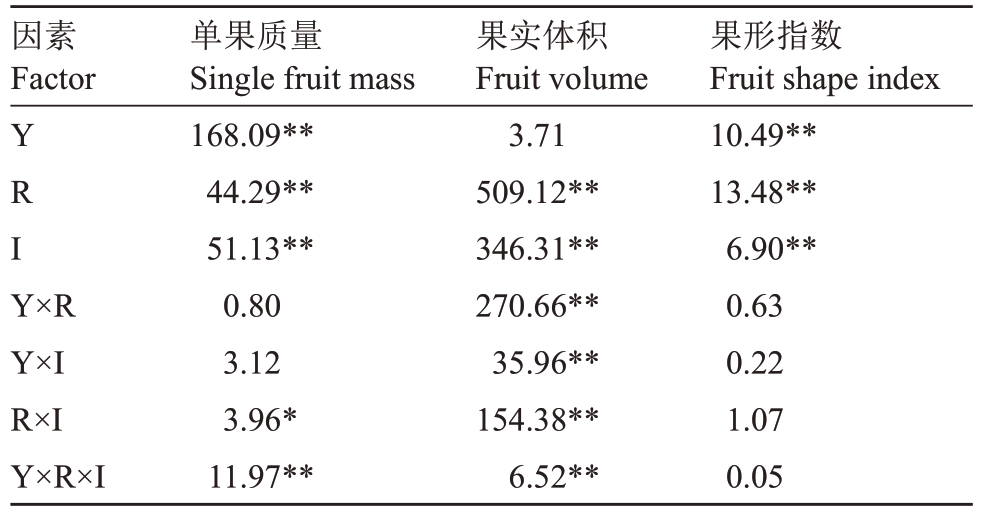
注:Y 为年份,R 为是否进行复水,I 为灌溉方式,*表示在0.05 水平差异显著,**表示在0.01 水平差异极显著。下同。
Note:Y is the year, R is whether to rewater, I is the irrigation method, * indicates significant difference at 0.05 level, ** indicates extremely significant difference at 0.01 level.The same below.
因素Factor果形指数Fruit shape index 10.49**13.48**6.90**0.63 0.22 1.07 0.05 YRI Y×R Y×I R×I Y×R×I单果质量Single fruit mass 168.09**44.29**51.13**0.80 3.12 3.96*11.97**果实体积Fruit volume 3.71 509.12**346.31**270.66**35.96**154.38**6.52**
与CK相比,采用MRSI处理的库尔勒香梨在单果质量、果实体积和果形指数等方面均显示出更优的表现(图3)。R2B 处理下的单果质量最大,为145.67~153.71 g;CK 最小,与其他处理间均呈显著差异。与CK 相比,R2B 处理的单果质量显著提高了24.56%~27.13%。2022 年,R2B 处理的果实体积最大,为141.94 mL,CK 最小,为104.94 mL;2023 年R1B 处理的果实体积最大,为147.40 mL,而R2U 处理的果实体积最小,为103.73 mL。在果形指数方面,R2B处理的果形指数最高,为1.15~1.16,与R1U、R1A处理和CK呈显著差异。
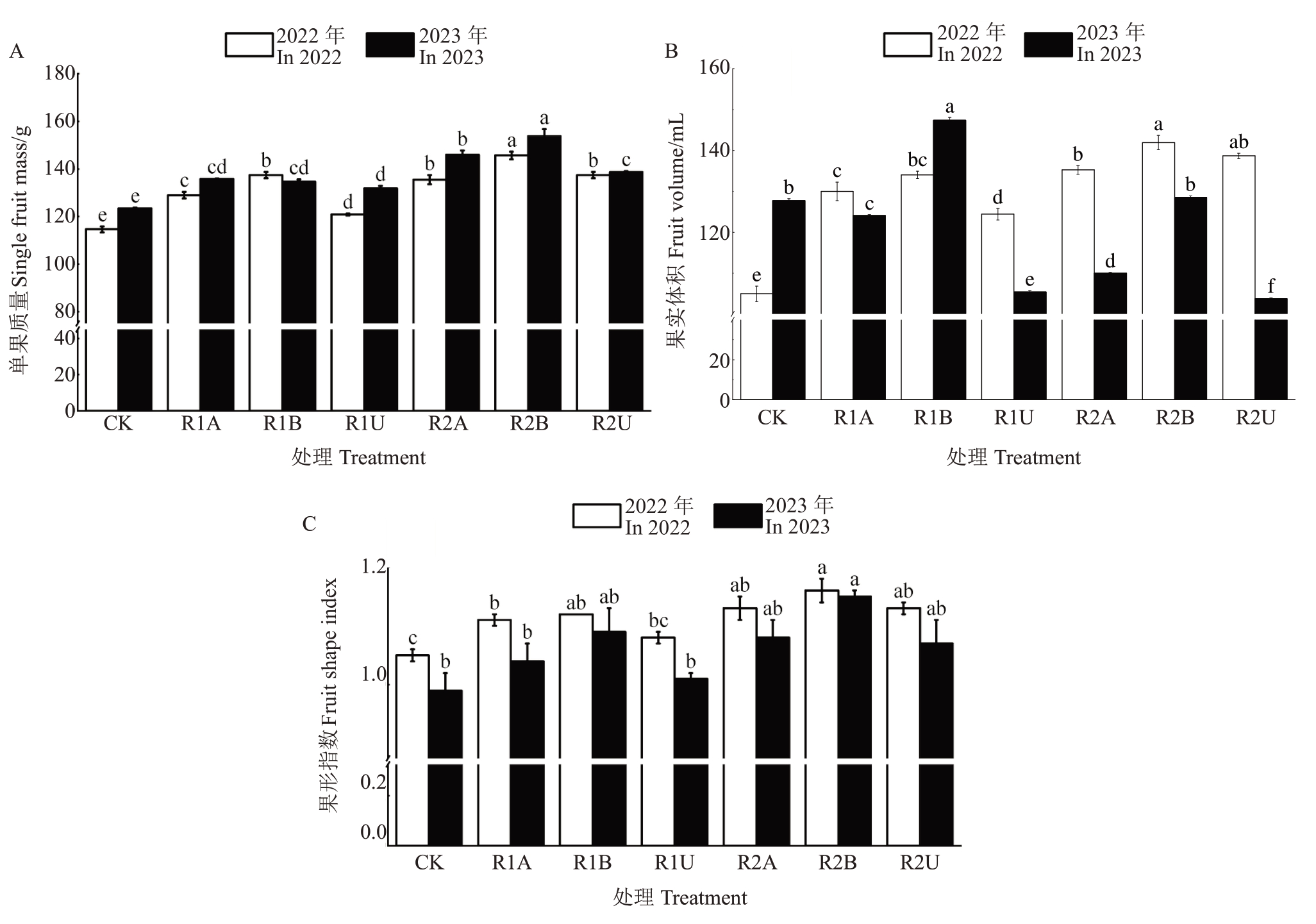
图3 不同灌溉方式对库尔勒香梨果实外观品质的影响Fig.3 Effects of different irrigation methods on the appearance quality of fruit of Kuerlexiangli pear
不同小写字母表示在0.05 水平差异显著。下同。
Different small letters indicate significant difference at 0.05 level.The same below.
2.1.2 内在品质 由表3 可知,是否复水对果实可溶性固形物含量、去皮硬度、维生素C 含量、可滴定酸含量、可溶性蛋白含量和石细胞含量均具有极显著影响。灌溉方式和年份对果实可溶性固形物含量、去皮硬度、可溶性糖含量、维生素C含量、可滴定酸含量、石细胞含量和果实含水量均具有显著或极显著影响。进一步分析发现,灌溉方式与是否复水两因素的交互作用对果实维生素C 含量、可滴定酸含量、果实含水量具有极显著影响。此外,灌溉方式、是否复水与年份三因素的交互作用对果实可溶性固形物含量、维生素C 含量和可滴定酸含量产生了极显著影响。
表3 不同灌溉方式、是否复水、年份及其交互作用对库尔勒香梨果实内在品质的方差分析
Table 3 Analysis of variance(ANOVA)of the intrinsic quality of fruit of Kuerlexiangli pear with different irrigation methods,with or without re-watering,year and their interactions

因素Factor YRI Y×R Y×I R×I Y×R×I可溶性固形物含量Soluble solids content 69.34**17.84**113.27**1.06 1.49 1.84 10.22**去皮硬度Tare hardness 11.03**131.23**16.09**5.71*2.03 0.09 1.21可溶性糖含量Soluble sugar content 15.58**2.72 25.02**6.73*1.2 0.72 0.56维生素C含量Vitamin C content 1 267.93**715.37**184.06**249.86**12.40**7.82**14.22**可滴定酸含量Titratable acid content 36.37**112.79**80.02**6.87*3.36 59.30**5.80**可溶性蛋白含量Soluble protein content 0.66 21.21**2.46 0.31 0.26 2.23 0.79石细胞含量Stone cell content 161.63**13.74**218.71**4.24 33.04**0.59 1.47果实含水量Fruit water content 7.48*1.57 7.69**3.01 1.37 5.85**2.24
与CK相比,MSRI处理显著提高了果实可溶性固形物和维生素C含量,降低了果实的去皮硬度,从而提高了香梨果实的内在品质(图4)。在去皮硬度方面,R2B处理的果实硬度最低,比CK分别显著降低了2.58%~4.62%。在R2B 处理下,果实可溶性固形物和可溶性糖含量均达到最大值,与CK相比,分别显著提高了15.00%~28.61%和18.62%~26.86%。关于可滴定酸含量,2022年,R1A处理的含量最高,而2023年,R1U处理的含量最高。在可溶性蛋白含量方面,2022 年各处理间无显著差异。此外,R2B处理的石细胞含量最低,与CK 相比显著降低了85.84%~86.26%。在果实含水量方面,2022 年R1B处理的果实最高,与CK、R2A、R2B、R2U 处理无显著差异;2023 年CK 最高,与R1A、R2A 处理无显著差异,但显著高于其他处理。
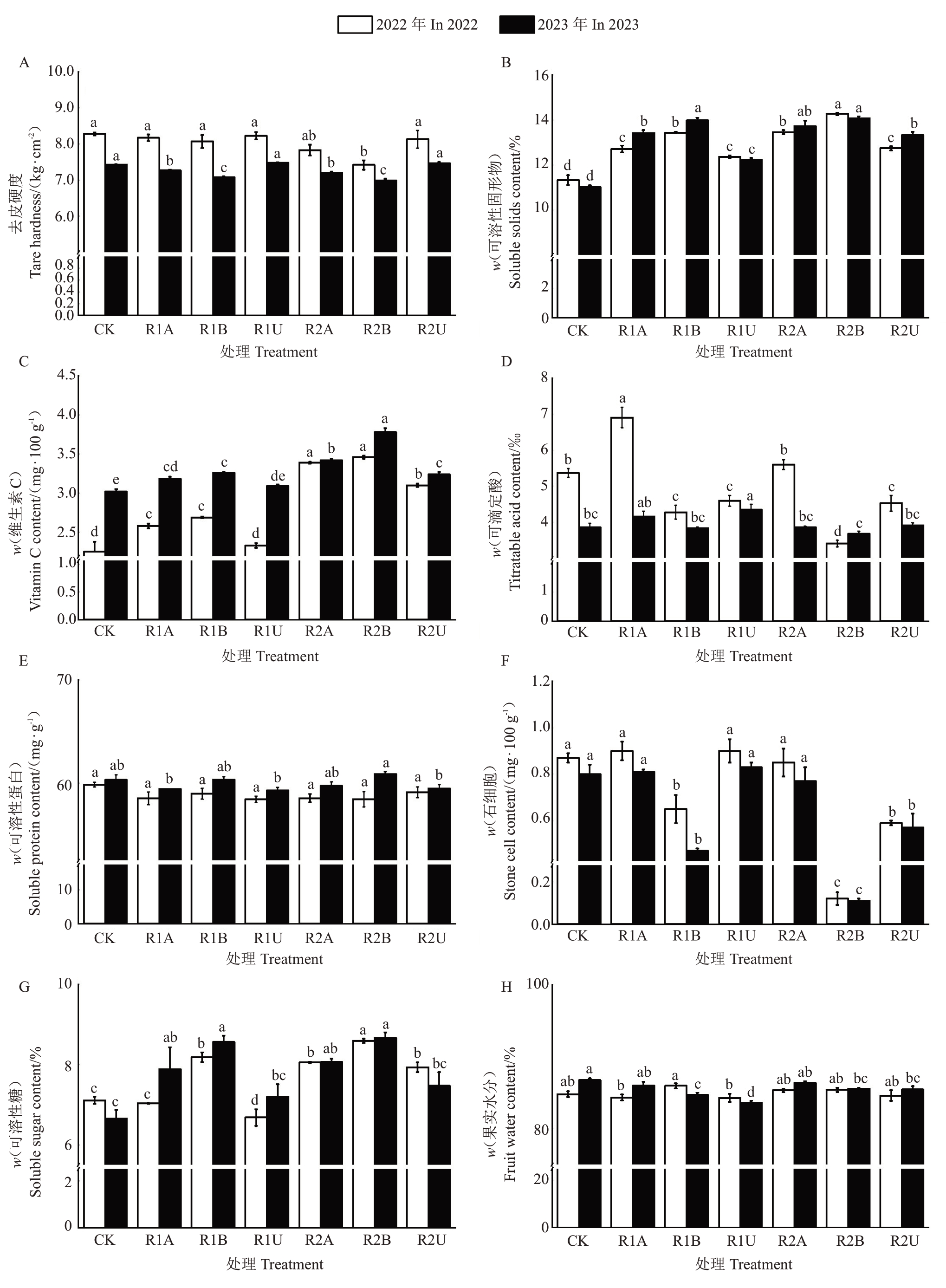
图4 不同灌溉方式对库尔勒香梨果实内在品质的影响
Fig.4 Effects of different irrigation methods on the intrinsic quality of fruit of Kuerlexiangli pear
2.2 不同灌溉方式对库尔勒香梨产量及水分利用效率的影响
从表4可以看出,灌溉方式、是否复水以及年份对库尔勒香梨的产量和水分利用效率均具有极显著影响。灌溉方式与是否复水、灌溉方式与年份及是否复水与年份两因素的交互作用对库尔勒香梨的产量和水分利用效率均具有极显著影响,然而,灌溉方式、是否复水与年份三因素的交互作用对香梨的产量和水分利用效率无显著影响。
表4 不同灌溉方式、是否复水、年份及其交互作用对库尔勒香梨产量与水分利用效率的方差分析
Table 4 Analysis of variance(ANOVA)of yield and water use efficiency of Kuerlexiangli pear with different irrigation methods,with or without re-watering,years and their interactions

因素Factor产量Yield 21.93**793.40**59.21**水分利用效率Water use efficiency 167.61**675.70**55.42**水分利用效率Water use efficiency 54.39**11.26**YRX因素Factor Y×R Y×X产量Yield 17.87**6.48**因素Factor R×X Y×R×X产量Yield 23.84**0.57水分利用效率Water use efficiency 20.52**1.49
从图5 可以看出,不同灌溉方式对库尔勒香梨的产量和水分利用效率均有显著影响。与CK 相比,采用MRSI处理提高了库尔勒香梨的产量,极显著提高了水分利用效率。从灌溉方式看,B 处理显著提高了库尔勒香梨的产量,极显著提高了水分利用效率,从是否进行复水来看,2023年,R2处理的库尔勒香梨产量与水分利用效率与R1 处理呈显著差异。R2B 处理的库尔勒香梨产量最高,与CK 相比显著提高了64.29%~90.73%。同时,水分利用效率也最高,与CK相比显著提高了230.61%~271.96%。
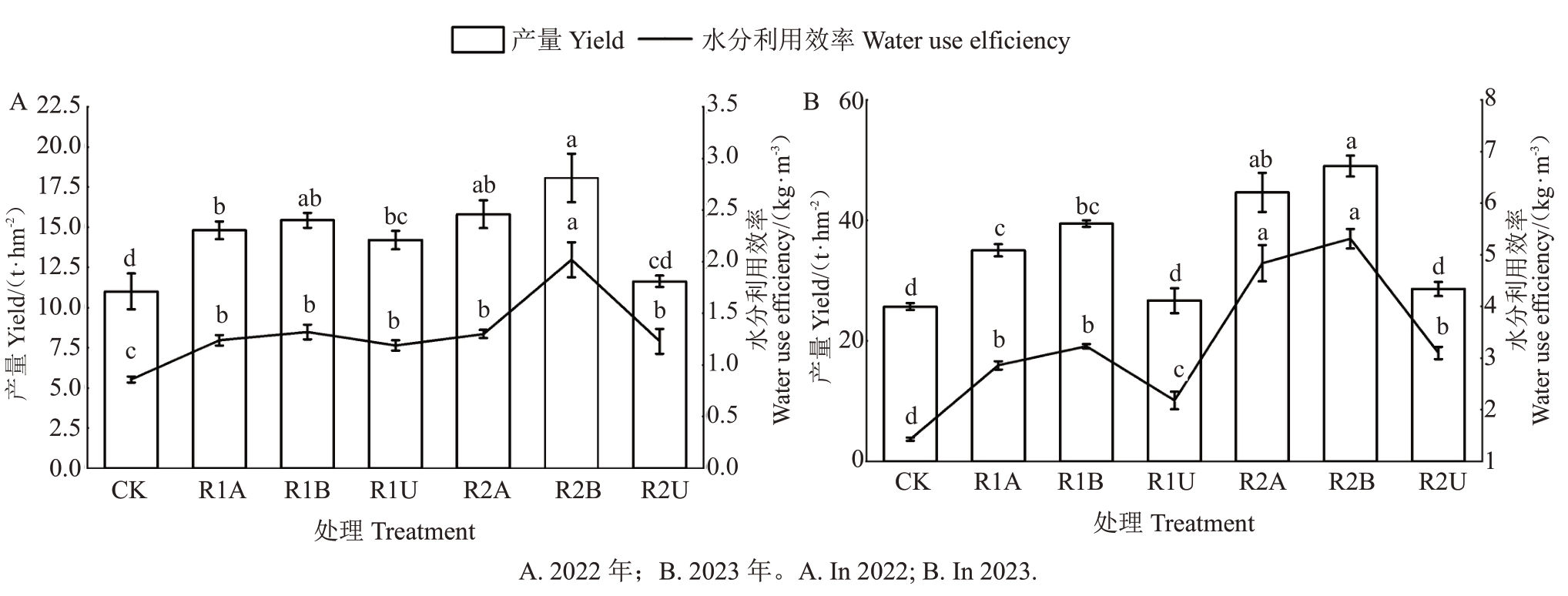
图5 不同灌溉方式对库尔勒香梨产量和水分利用效率的影响
Fig.5 Effects of different irrigation methods on irrigation water use efficiency and yield of Kuerlexiangli pear
2.3 库尔勒香梨果实品质、产量和水分利用效率的相关性分析
图6 展示了果实品质、产量和水分利用效率之间的相关性。其中,产量与可溶性固形物含量、可溶性糖含量、维生素C 含量、单果质量、可溶性蛋白含量以及水分利用效率呈极显著正相关,与去皮硬度、可滴定酸含量呈极显著负相关,与石细胞含量呈显著负相关。水分利用效率同样与可溶性固形物含量、可溶性糖含量、维生素C含量、单果质量、可溶性蛋白含量呈极显著正相关,而与去皮硬度、可滴定酸含量、石细胞含量呈极显著负相关。
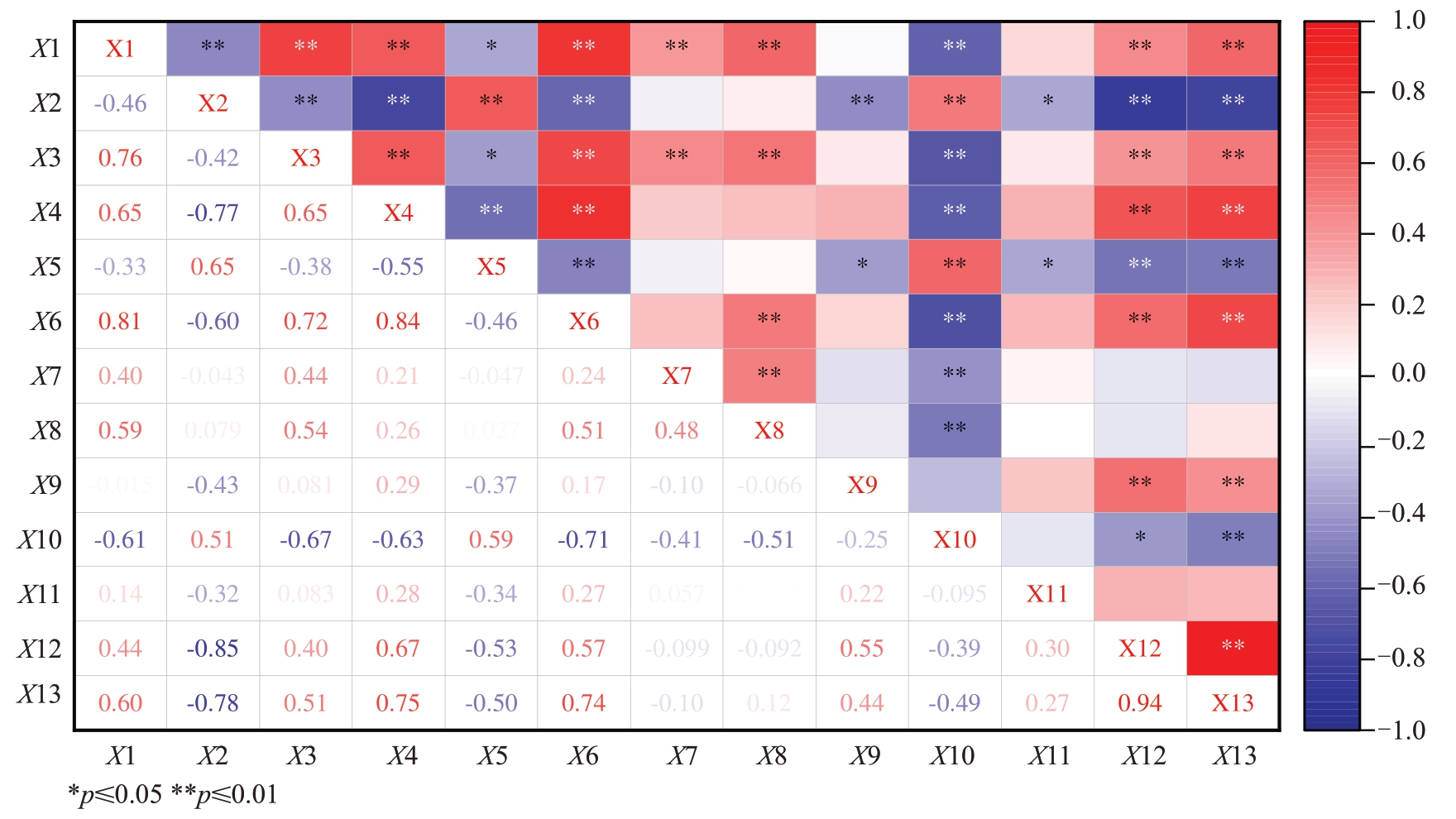
图6 库尔勒香梨果实品质与产量、水分利用效率的相关性分析
Fig.6 Correlation analysis of fruit quality,yield and water use efficiency of Kuerlexiangli pear
其中X1 为可溶性固形物含量,X2 为去皮硬度,X3 为可溶性糖含量,X4 为维生素C 含量,X5 为可滴定酸含量,X6 为单果质量,X7 为果实体积,X8 为果形指数,X9 为可溶性蛋白含量,X10 为石细胞含量,X11 为果实含水量,X12 为产量,X13 为水分利用效率。*表示在0.05 水平相关性显著,**表示在0.01 水平相关性极显著。
X1 means soluble solid content, X2 means tare hardness, X3 means soluble sugar content, X4 means vitamin C, X5 means titratable acid content,X6 means single fruit mass,X7 means fruit volume,X8 means fruit shape index,X9 means soluble protein content,X10 means stone cell content,X11 means fruit water content,X12 means yield,X13 means water use efficiency.*indicates significant correlation at 0.05 level,**indicates extremely significant correlation at 0.01 level.
2.4 综合评价
笔者采用主成分分析法(PCA)和优劣解距离法(TOPSIS)对库尔勒香梨的果实品质、产量及水分利用效率等13个指标进行综合评价,包括可溶性固形物含量、可溶性糖含量、维生素C含量、单果质量、果实体积、果形指数、可溶性蛋白含量、果实含水量、单位面积产量、水分利用效率等10 个正向指标,以及去皮硬度、可滴定酸含量、石细胞含量等3个负向指标。对正向指标与负向指标分别进行均一化处理,确保数据的可比性和分析的有效性。如表5 所示,通过PCA 得出各处理的综合得分从高到低依次为R2B>R2A>R1B>R2U>R1A>R1U>CK,而通过TOPSIS 分析得出各处理的综合得分从高到低依次为R2B>R1B>R2A>R2U>R1A>CK>R1U。 2种综合评价方法均显示R2B处理最优,表明R2B处理是最适宜库尔勒香梨的灌溉方式。
表5 不同灌溉方式对库尔勒香梨果实品质、产量及水分利用效率的综合评价
Table 5 Comprehensive evaluation of different irrigation methods on fruit quality,yield and water use efficiency of Kuerlexiangli pear

处理Treatment优劣解距离法TOPSIS 主成分分析法PCA PC1-1.08-0.42 0.40-0.87 0.44 1.50 0.03 PC2-1.09 0.10 0.54-0.40-0.01 0.68 0.18综合得分Overall score-0.73-0.18 0.30-0.50 0.21 0.86 0.05排名Ranking D-D+C 排名Ranking CK R1A R1B R1U R2A R2B R2U 7536214 0.39 0.53 0.78 0.32 0.73 0.97 0.62 0.28 0.24 0.14 0.28 0.19 0.03 0.20 0.58 0.69 0.84 0.53 0.79 0.97 0.75 6527314
3 讨 论
果实品质是影响消费者选择和喜好的关键因素之一,因此,在节水灌溉的同时如何保持甚至提升果实品质成为研究的重点内容。本试验中,与漫灌相比,改进涌泉根灌(MRSI)显著提升了库尔勒香梨果实的单果质量、果形指数、维生素C 含量、可溶性糖含量以及可溶性固形物含量,同时有效降低了果实的去皮硬度、石细胞含量以及可滴定酸含量。这与戚飞[23]的研究结果一致,其原因可能是涌泉根灌将水分、养分直接输送到植物的根系,促进了根系对水分和养分的吸收利用[30]。此外,本试验还发现,在相同的灌水方式下,不复水处理的果实可溶性糖含量和可溶性固形物含量均高于复水处理,表明减少灌水量,一定的水分胁迫可以提高果实品质,这与Hao等[31]的研究结果一致。进一步分析表明,灌水量一定时,双侧涌泉根灌处理的果实品质最佳,优于交替涌泉根灌和单侧涌泉根灌。刘星等[32]在地表滴灌的背景下,通过设置双侧灌溉、交替灌溉和单侧灌溉3种灌溉方式,研究发现适度灌溉的分根交替滴灌处理能一定程度上提高苹果的果实品质,这与本试验结果不相符,其原因可能是一方面本试验交替灌溉时间间隔长,香梨树体受到持续的干旱胁迫,从而降低了果实品质;另一方面本试验采用的灌溉方式为涌泉根灌,灌水器的深度距地表30 cm,而库尔勒香梨的根系主要分布在20~60 cm 处[8],灌溉时水分可以直接输送到根系,与地表滴灌水分变化对根系的影响相比,双侧灌溉可以使库尔勒香梨根系处于适宜的水分环境下,从而促进养分的吸收,提高果实品质[33]。
在保持果实品质的同时,提高产量和水分利用效率同样是节水灌溉的考虑因素。合理的灌溉方式能够协调作物营养物质的分配,从而提高果实产量。李中杰[21]研究了不同灌溉方式和灌水量对山地苹果产量和水分利用效率的影响,结果表明,相较于其他灌溉方式,涌泉根灌对产量和水分利用效率有着更显著的提升作用。车银伟等[34]的研究结果也证实了涌泉根灌可以显著提高山地梨枣的产量与水分利用效率。本试验研究表明,与漫灌相比,MRSI显著提高了库尔勒香梨的产量和水分利用效率,与前人的研究结果一致[35]。其原因可能是:一方面漫灌对土壤表面的湿润面积大,使其蒸发量增大,入渗的水分明显减少;而涌泉根灌直接将水分输送到香梨的根部,减少了地面的无效蒸发,可使所灌的水分发挥更有效的作用,相应地提高了水分利用效率[36-37];另一方面涌泉根灌直接将水分输送到果树根系,根系活力增强,进而提高了产量[38]。在果实膨大期,不复水的处理方式在产量上并未显著低于复水处理,表明该时期复水处理并未对库尔勒香梨产量带来明显的积极影响,从而进一步说明减少灌水量可以提高库尔勒香梨的产量,这与汪精云等[29]、赵先飞等[39]的结果相似。
本研究结果表明,当灌水量一定时,双侧灌溉处理的库尔勒香梨产量和水分利用效率最高,交替灌溉次之,单侧灌溉最低。其原因可能是双侧灌溉处理可以将相同的灌水量均匀分配到果树的根系,从而减少了水分深层渗漏量,提高了水分利用效率[22]。
4 结 论
笔者通过2 年的田间试验,相较于传统的漫灌方式,双侧涌泉根灌不复水(R2B)处理的库尔勒香梨果实可溶性固形物含量、可溶性糖含量、产量以及水分利用效率均为最高,可滴定酸含量和石细胞含量最低,综合表现最好。此外,与CK 相比,R2B 处理节省了48.68%的灌水量。因此,R2B处理可以作为干旱区库尔勒香梨适宜的灌溉方式。
[1] MBABAZI D,MIGLIACCIO K W,CRANE J H,FRAISSE C,ZOTARELLI L,MORGAN K T,KIGGUNDU N.An irrigation schedule testing model for optimization of the Smartirrigation avocado app[J]. Agricultural Water Management,2017,179:390-400.
[2] HOLT N,SISHODIA R P,SHUKLA S,HANSEN K M. Improved water and economic sustainability with low-input compact bed plasticulture and precision irrigation[J]. Journal of Irrigation and Drainage Engineering,2019,145(7):04019013.
[3] 曹雪,阿依吐尔逊·沙木西,金晓斌,周寅康.水资源约束下的干旱区种植业结构优化分析:以新疆库尔勒市为例[J].资源科学,2011,33(9):1714-1719.CAO Xue,Shamxi Ayitursun,JIN Xiaobin,ZHOU Yinkang.Planting structure optimization in the arid area with constrained water resources:A case study of Korla,Xinjiang[J]. Resources Science,2011,33(9):1714-1719.
[4] 雷米,周金龙,曾妍妍,范薇,魏兴,孙英.干旱区绿洲城市地下水超采区综合治理研究:以新疆库尔勒市为例[J].南水北调与水利科技,2019,17(2):67-74.LEI Mi,ZHOU Jinlong,ZENG Yanyan,FAN Wei,WEI Xing,SUN Ying. Comprehensive treatments of groundwater over-exploitation in arid oasis city:A case of Korla city in Xinjiang[J].South-to-North Water Transfers and Water Science &Technology,2019,17(2):67-74.
[5] 何振嘉,范王涛,杜宜春,潘岱立.涌泉根灌节水灌溉技术特点、应用及展望[J].农业工程学报,2020,36(8):287-298.HE Zhenjia,FAN Wangtao,DU Yichun,PAN Daili.Characteristics,application and prospects of bubbled- root irrigation[J].Transactions of the Chinese Society of Agricultural Engineering,2020,36(8):287-298.
[6] 位杰,谢宏江,蒋媛.巴州地区库尔勒香梨产业现状、问题及持续发展对策[J].果树资源学报,2024,5(5):108-112.WEI Jie,XIE Hongjiang,JIANG Yuan. Current situation,problems and sustainable development countermeasures of Korla fragrant pear industry in Bazhou area[J]. Journal of Fruit Resources,2024,5(5):108-112.
[7] 张峰,蒋志琴,陈小光,李世强,何天明.库尔勒香梨产业发展因素分析及对策建议[J]. 中国农学通报,2021,37(34):159-164.ZHANG Feng,JIANG Zhiqin,CHEN Xiaoguang,LI Shiqiang,HE Tianming. The development factors of Pyrus sinkiangensis‘Korla Xiangli’industry[J].Chinese Agricultural Science Bulletin,2021,37(34):159-164.
[8] 邓永辉,兖攀,郑强卿,陈奇凌,王振东,王文军,王晶晶,张锦强.漫灌下幼树期库尔勒香梨根系分布特征研究[J].植物营养与肥料学报,2023,29(8):1563-1572.DENG Yonghui,YAN Pan,ZHENG Qiangqing,CHEN Qiling,WANG Zhendong,WANG Wenjun,WANG Jingjing,ZHANG Jinqiang.Distribution of young Korla fragrant pear tree roots under flooding irrigation[J].Journal of Plant Nutrition and Fertilizers,2023,29(8):1563-1572.
[9] 张景瑞,王春霞,马建江,王佳鑫,王宏鑫,周方圆,李彦杰,王远. 滴灌定额对香梨耗水特征的影响[J]. 灌溉排水学报,2024,43(7):29-38.ZHANG Jingrui,WANG Chunxia,MA Jianjiang,WANG Jiaxin,WANG Hongxin,ZHOU Fangyuan,LI Yanjie,WANG Yuan.The influence of drip irrigation amount on water consumption of fragrant pear[J].Journal of Irrigation and Drainage,2024,43(7):29-38.
[10] 王春峰,张峰,程嘉宝,关晓媛,秦飞.库尔勒香梨产业发展现状、存在问题与对策建议[J]. 果树资源学报,2024,5(5):88-91.WANG Chunfeng,ZHANG Feng,CHENG Jiabao,GUAN Xiaoyuan,QIN Fei. Current status,main problems and the suggestions on development of Korla fragrant pear[J]. Journal of Fruit Resources,2024,5(5):88-91.
[11] 刘洪波,张江辉,白云岗,张胜江,丁平.滴灌条件下库尔勒香梨耗水特征分析[J].新疆农业科学,2014,51(12):2206-2211.LIU Hongbo,ZHANG Jianghui,BAI Yungang,ZHANG Shengjiang,DING Ping. Water consumption characteristics of Korla pear under drip irrigation[J].Xinjiang Agricultural Sciences,2014,51(12):2206-2211.
[12] 郭长强,崔远来,李新建,粟世华.广西糖料甘蔗需水量和灌溉定额空间变异[J].农业工程学报,2016,32(8):89-97.GUO Changqiang,CUI Yuanlai,LI Xinjian,SU Shihua. Spatial variation of sugarcane water requirement and irrigation quota in Guangxi[J]. Transactions of the Chinese Society of Agricultural Engineering,2016,32(8):89-97.
[13] 章垚.根区渗灌对库尔勒香梨生长影响研究[D].石河子:石河子大学,2023.ZHANG Yao. Effect of root zone infiltration irrigation on the growth of Korla fragrant pear[D]. Shihezi:Shihezi University,2023.
[14] WANG L L,WU W Y,XIAO J,HUANG Q N,HU Y Q.Effects of different drip irrigation modes on water use efficiency of pear trees in Northern China[J]. Agricultural Water Management,2021,245:106660.
[15] 钟韵,费良军,曾健,傅渝亮,代智光.根域水分亏缺对涌泉灌苹果幼树产量品质和节水的影响[J].农业工程学报,2019,35(21):78-87.ZHONG Yun,FEI Liangjun,ZENG Jian,FU Yuliang,DAI Zhiguang. Effects of root-zone water deficit on yield,quality and water use efficiency of young apple trees under surge-root irrigation[J].Transactions of the Chinese Society of Agricultural Engineering,2019,35(21):78-87.
[16] PENG Y L,FEI L J,HAO K,JIE F L,SHEN F Y,LIU L H,FAN Q W. Effects of water and nitrogen coupling on apple yield,soil water and nitrogen distribution,and enzyme activity under surge-root irrigation in Loess Plateau,China[J].Journal of Soil Science and Plant Nutrition,2023,23(4):5177-5195.
[17] DAI Z G,FEI L J,HUANG D L,ZENG J,CHEN L,CAI Y H.Coupling effects of irrigation and nitrogen levels on yield,water and nitrogen use efficiency of surge-root irrigated jujube in a semiarid region[J].Agricultural Water Management,2019,213:146-154.
[18] 张俊,缑丽娜,何振嘉,肖欣怡,梁飞,任虎兴,傅渝亮.肥液浓度对双点源涌泉根灌土壤入渗特征及水分运移的影响[J].节水灌溉,2023(8):10-16.ZHANG Jun,GOU Lina,HE Zhenjia,XIAO Xinyi,LIANG Fei,REN Huxing,FU Yuliang. Effect of fertilizer concentration on soil infiltration characteristics and water transport under double point source in bubbled-root irrigation[J].Water Saving Irrigation,2023(8):10-16.
[19] 赵新宇,胡羊羊,彭江涌,朱绿丹.灌水流量对涌泉灌及涌泉根灌湿润体影响的研究[J].节水灌溉,2021(11):71-73.ZHAO Xinyu,HU Yangyang,PENG Jiangyong,ZHU Lüdan.Effect of irrigation flow on the wetting body of bubbled irrigation and bubbled-root irrigation[J].Water Saving Irrigation,2021(11):71-73.
[20] 代智光,蔡耀辉.灌水器埋深对红壤区涌泉根灌双点源入渗水氮运移的影响[J].灌溉排水学报,2021,40(7):9-15.DAI Zhiguang,CAI Yaohui. The effects of depth of subsurface dual emitters in surge-root irrigation on water and nitrogen movement in red soil[J]. Journal of Irrigation and Drainage,2021,40(7):9-15.
[21] 李中杰.不同灌溉技术和灌水量的陕北山地苹果节水增产提质效应研究[D].西安:西安理工大学,2021.LI Zhongjie. Effect of different irrigation techniques and irrigation amounts on water saving,yield increase and quality improvement of mountain apple in northern of Shaanxi[D].Xi’an:Xi’an University of Technology,2021.
[22] 刘晓丽,马理辉,岩晓莹,杨荣慧,訾浩.不同灌水方式对沙地枸杞土壤水分及产量的影响[J].灌溉排水学报,2020,39(2):10-15.LIU Xiaoli,MA Lihui,YAN Xiaoying,YANG Ronghui,ZI Hao.Effect of different irrigation method on sandy soil moisture and yield of wolfberry[J]. Journal of Irrigation and Drainage,2020,39(2):10-15.
[23] 戚飞.三种灌溉方式对苹果食用及营养品质的影响[D].杨凌:西北农林科技大学,2018.QI Fei. Effect of three drip irrigation methods on edible and nutritional quality of apple[D].Yangling:Northwest A&F University,2018.
[24] 吴普特,朱德兰,汪有科.涌泉根灌技术研究与应用[J].排灌机械工程学报,2010,28(4):354-357.WU Pute,ZHU Delan,WANG Youke. Research and application of bubbled-root irrigation[J]. Journal of Drainage and Irrigation Machinery Engineering,2010,28(4):354-357.
[25] 苏彦尹. 基于实时气象资料苹果树耗水量简便计算方法研究[D].北京:中国科学院大学(中国科学院教育部水土保持与生态环境研究中心),2020.SU Yanyin. Study on simple calculation method of water consumption of orchard based on real-time meteorological data[D].Beijing:University of Chinese Aeademy of Seienees (Institute of Soil and Water Conservation,CAS&MWR),2020.
[26] SUN G Z,HU T T,LIU X G,PENG Y L,LENG X X,LI Y L,YANG Q L. Optimizing irrigation and fertilization at various growth stages to improve mango yield,fruit quality and waterfertilizer use efficiency in xerothermic regions[J]. Agricultural Water Management,2022,260:107296.
[27] 高俊凤. 植物生理学实验指导[M]. 北京:高等教育出版社,2006.GAO Junfeng. Experimental guidance for plant physiology[M].Beijing:Higher Education Press,2006.
[28] 聂继云,李静,杨振锋,张红军,李明强.冷冻法测定梨的石细胞含量[J].果树学报,2006,23(1):133-135.NIE Jiyun,LI Jing,YANG Zhenfeng,ZHANG Hongjun,LI Mingqiang. Study on the conditions for measuring stone cell content in pear flesh by freezing method[J].Journal of Fruit Science,2006,23(1):133-135.
[29] 汪精云,费良军,李中杰,郝琨,刘腾.轻度调亏涌泉根灌提高山地苹果产量、品质及水分利用效率[J].排灌机械工程学报,2024,42(8):835-842.WANG Jingyun,FEI Liangjun,LI Zhongjie,HAO Kun,LIU Teng. Light regulated deficit surge-root irrigation improvement of yield,quality and water use efficiency of mountain apple[J].Journal of Drainage and Irrigation Machinery Engineering,2024,42(8):835-842.
[30] LIU X,XU Y Y. Effect of integration of water and fertilizer on soil water-nitrogen transport characteristics in bubbled-root irrigation[J].Irrigation Science,2023,41(3):379-393.
[31] HAO K,FEI L J,LIU L H,JIE F L. Improving fruit yield and quality of mountain apple(Malus domestica Borkh.cv.Hanfu)by light deficit surge-root irrigation in the Loess Plateau,China[J].Journal of Soil Science and Plant Nutrition,2022,22(2):1506-1519.
[32] 刘星,曹红霞,廖阳,周宸光,李黄涛.滴灌模式对苹果光合特性、产量及灌溉水利用的影响[J]. 中国农业科学,2021,54(15):3264-3278.LIU Xing,CAO Hongxia,LIAO Yang,ZHOU Chenguang,LI Huangtao. Effects of drip irrigation methods on photosynthetic characteristics,yield and irrigation water use of apple[J]. Scientia Agricultura Sinica,2021,54(15):3264-3278.
[33] 代顺冬.涌泉根灌条件下枣树高效灌溉施肥模式研究[D].杨凌:西北农林科技大学,2013.DAI Shundong. Research on fertigation models of jujube under bubble-root irrigation[D].Yangling:Northwest A& F University,2013.
[34] 车银伟,林佳,胡田田,朱德兰,党思思.涌泉根灌对山地梨枣产量形成及水分利用的影响[J].西北农林科技大学学报(自然科学版),2012,40(1):177-182.CHE Yinwei,LIN Jia,HU Tiantian,ZHU Delan,DANG Sisi.Effect of surge spring root irrigation on yield and water use of jujube on mountain land[J].Journal of Northwest A&F University(Natural Science Edition),2012,40(1):177-182.
[35] 杨震,费良军,李哲,彭有亮,郝琨,刘腾.不同灌水技术下水氮耦合对山地苹果产量和品质及水氮利用的影响[J].水土保持学报,2023,37(3):267-272.YANG Zhen,FEI Liangjun,LI Zhe,PENG Youliang,HAO Kun,LIU Teng.Effects of water-nitrogen coupling under different irrigation techniques on yield and quality of mountain apples and water and fertilizer utilization[J]. Journal of Soil and Water Conservation,2023,37(3):267-272.
[36] 黎朋红,汪有科,马理辉,赵颖娜,段雪松.涌泉根灌湿润体特征值变化规律研究[J].水土保持学报,2009,23(6):190-194.LI Penghong,WANG Youke,MA Lihui,ZHAO Yingna,DUAN Xuesong. Study on eigenvalues of wetted soil under surge root irrigation[J]. Journal of Soil and Water Conservation,2009,23(6):190-194.
[37] DAI Z G,FEI L J,LI P,CHEN L,ZHONG Y. Suitable strategy of water-nitrogen management for surge-root irrigation of jujube in China[J].Agronomy Journal,2018,110(4):1390-1401.
[38] WANG H D,LI J,CHENG M H,ZHANG F C,WANG X K,FAN J L,WU L F,FANG D P,ZOU H Y,XIANG Y Z.Optimal drip fertigation management improves yield,quality,water and nitrogen use efficiency of greenhouse cucumber[J].Scientia Horticulturae,2019,243:357-366.
[39] 赵先飞,张馨予,于国康,梁洁,赵紫嫣,刘宇,张林森.短枝富士苹果不同负载和灌水量对新梢生长、产量和灌水利用效率的影响[J].果树学报,2023,40(9):1860-1870.ZHAO Xianfei,ZHANG Xinyu,YU Guokang,LIANG Jie,ZHAO Ziyan,LIU Yu,ZHANG Linsen. Effect of different fruit loads and irrigation amounts on new shoot growth,yield and irrigation water use efficiency in spur-type Fuji apples[J]. Journal of Fruit Science,2023,40(9):1860-1870.